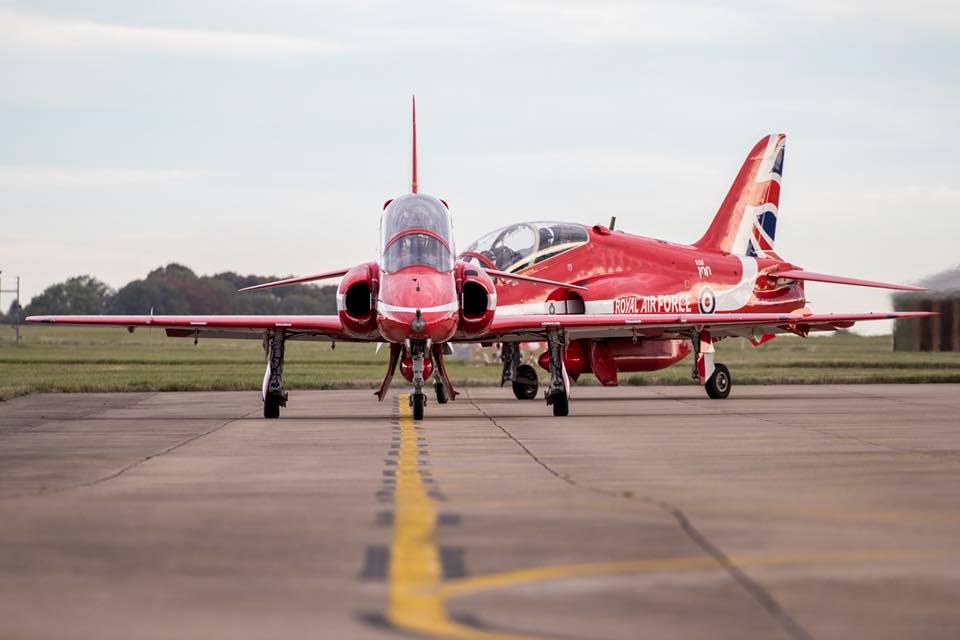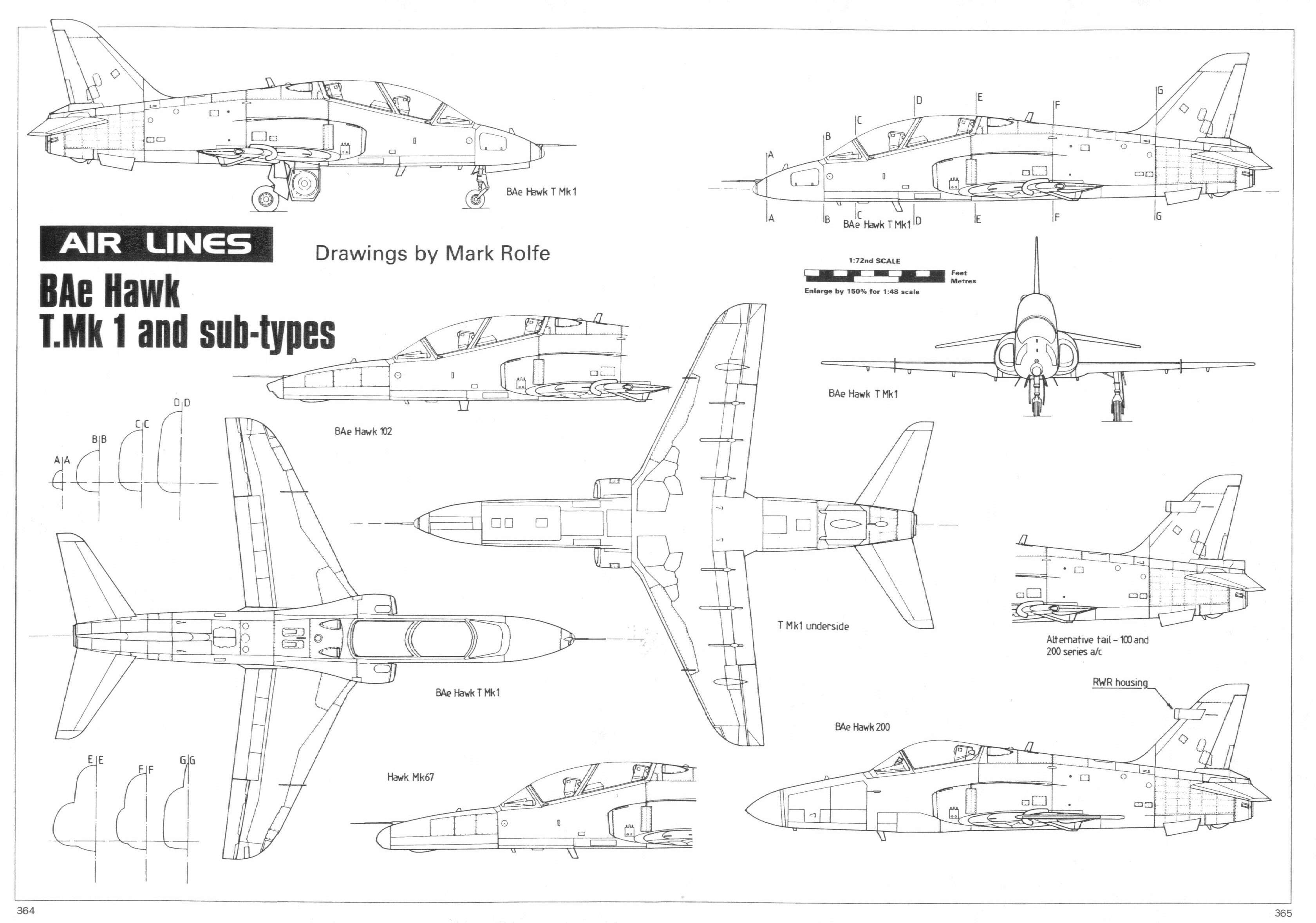BabyBrit
Fly jacRC
History:

In 1964, the Royal Air Force specified a requirement (Air Staff Target, AST, 362) for a new fast jet trainer to replace the Folland Gnat. The SEPECAT Jaguar was originally intended for this role, but it was soon realized that it would be too complex an aircraft for fast jet training and only a small number of two-seat versions were purchased. Accordingly, in 1968, Hawker Siddeley Aviation (HSA) began studies for a simpler aircraft, initially as a special project (SP) 117. The design team was led by Ralph Hooper
A Royal Air Force Hawk T1A at Kemble Airport, Gloucestershire, with its pilot
This project was funded by the company as a private venture, in anticipation of possible RAF interest. The design was conceived of as having tandem seating and a combat capability in addition to training, as it was felt the latter would improve export sales potential. By the end of the year HSA had submitted a proposal to the Ministry of Defence based on the design concept, and in early 1970 the RAF issued Air Staff Target (AST) 397 which formalized the requirement for new trainers of this type. The RAF selected the HS.1182 for their requirement on 1 October 1971 and the principal contract, for 175 aircraft, was signed in March 1972.
The prototype aircraft XX154 first flew on 21 August 1974 from Dunsfold piloted by Duncan Simpson, Chief Test Pilot of HSA (Kingston), reaching 20,000 ft in a flight lasting 53 minutes. All development aircraft were built on production jigs; the program remained on time and to budget throughout.[5] The Hawk T1 entered RAF service in late 1976. - Wiki
Note from the Builder:
This is a project stemmed from a love of this aircraft and a desire to getting into EDFs. As a pilot, I feel confident enough in my skill set that this will be both a fun and rewarding design and build process. This, unlike other designs I have produced in the past, I plan to incorporate foam as well as 3D printed components. Therefore the design and build will likely span over the course of several months. Its been a long while since I have been on the forum and I feel like a long form project such as this will help inspire others.
Progress Update:
11/19/18 - found plans, started template in fusion, and began post.
Design:

Actual Scale: 1:10
Plans:
I have always found google to be a great resource for finding plans and the design and this time has been no different. This set comes in straight from google and has been imported into Fusion360 as the base of the file.
Specs:
Minimum Battery Capacity:2200 mAh, 100 C, lithium polymer.
Suggested ESC Rating: 60 A to 85 A.
Power Into / Out of Motor: TBA
Power To Weight Ratio: TBA
Estimated Stall Speed: TBA
Electronics:
Motor: 70mm 12 Blade 6s EDF (3048-2150KV) - Motion RC link to follow.
esc: 75-80amp ** Changed to correct size to be purchased.
battery: 6s 2200mah 100 C or better (**likey will be 2 high C 3s packs in parallel)
Build:
TBD

In 1964, the Royal Air Force specified a requirement (Air Staff Target, AST, 362) for a new fast jet trainer to replace the Folland Gnat. The SEPECAT Jaguar was originally intended for this role, but it was soon realized that it would be too complex an aircraft for fast jet training and only a small number of two-seat versions were purchased. Accordingly, in 1968, Hawker Siddeley Aviation (HSA) began studies for a simpler aircraft, initially as a special project (SP) 117. The design team was led by Ralph Hooper
A Royal Air Force Hawk T1A at Kemble Airport, Gloucestershire, with its pilot
This project was funded by the company as a private venture, in anticipation of possible RAF interest. The design was conceived of as having tandem seating and a combat capability in addition to training, as it was felt the latter would improve export sales potential. By the end of the year HSA had submitted a proposal to the Ministry of Defence based on the design concept, and in early 1970 the RAF issued Air Staff Target (AST) 397 which formalized the requirement for new trainers of this type. The RAF selected the HS.1182 for their requirement on 1 October 1971 and the principal contract, for 175 aircraft, was signed in March 1972.
The prototype aircraft XX154 first flew on 21 August 1974 from Dunsfold piloted by Duncan Simpson, Chief Test Pilot of HSA (Kingston), reaching 20,000 ft in a flight lasting 53 minutes. All development aircraft were built on production jigs; the program remained on time and to budget throughout.[5] The Hawk T1 entered RAF service in late 1976. - Wiki
Note from the Builder:
This is a project stemmed from a love of this aircraft and a desire to getting into EDFs. As a pilot, I feel confident enough in my skill set that this will be both a fun and rewarding design and build process. This, unlike other designs I have produced in the past, I plan to incorporate foam as well as 3D printed components. Therefore the design and build will likely span over the course of several months. Its been a long while since I have been on the forum and I feel like a long form project such as this will help inspire others.
Progress Update:
11/19/18 - found plans, started template in fusion, and began post.
Design:

Actual Scale: 1:10
Plans:
I have always found google to be a great resource for finding plans and the design and this time has been no different. This set comes in straight from google and has been imported into Fusion360 as the base of the file.
Specs:
Length | 48.9" |
Wingspan | 39.1" |
Wing area | TBA |
Build level | Moderate/Challenging (3.7/5) |
Flight level | Challenge (4/5) |
Number of channels | TBA min 5-6 |
AUW | TBA (est ~2-3lbs) |
Wing loading | TBA |
Minimum Battery Capacity:2200 mAh, 100 C, lithium polymer.
Suggested ESC Rating: 60 A to 85 A.
Power Into / Out of Motor: TBA
Power To Weight Ratio: TBA
Estimated Stall Speed: TBA
Electronics:
Motor: 70mm 12 Blade 6s EDF (3048-2150KV) - Motion RC link to follow.
esc: 75-80amp ** Changed to correct size to be purchased.
battery: 6s 2200mah 100 C or better (**likey will be 2 high C 3s packs in parallel)
Build:
TBD
Last edited:



